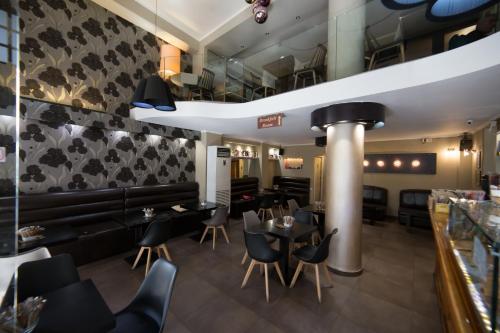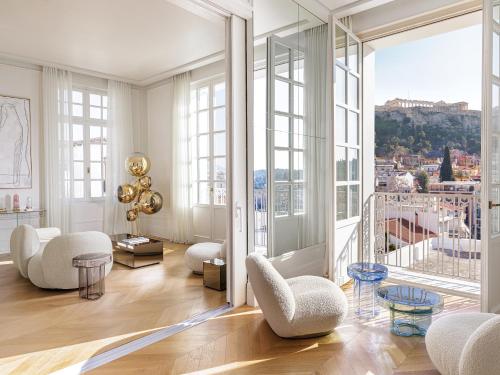Piece by piece, tiny tile by tiny tile, the Daphni Monastery has been restored. It’s taken years – perhaps even longer than it took to build in the first place – but it’s been worth it. Such is the art of making something old look old again.
It was 2012 when I first visited the monastery at Daphni, on the edge of Athens, and it was hard to appreciate its true wonder. As you can see from this photo, the outside was covered in scaffolding – and the interior was even worse:
The World Heritage Site had been hit by a devastating earthquake in 1999 and had been badly damaged. A major project was needed to not only fix it, but stabilise it in case of any future shocks.
This ended up taking almost two decades!
But now, on my return visit, everything is open again and you can already see the comparison in this photo:
Perhaps more importantly than seeing the exterior without the scaffolding, you can now also go inside and get a clear view of the interior walls. And this is important, because this is where you’ll find the true treasures of the Daphni Monastery.
The religious site certainly has interesting 11th-century Byzantine architecture, but the artworks are where it really shines. The colourful and detailed mosaics that cover the walls – and particularly the inside of the dome – are incredible.
That so much of the original mosaic work is still intact is also impressive, and there’s certainly plenty here to give you a sense of how it would’ve looked when the whole church was covered in this vibrant iconography.
To now see it all properly for myself is amazing, and I’m really glad I made the time to come back.
What is the Daphni Monastery?
The Daphni Monastery is a small religious site built in the 11th century on the outskirts of modern-day Athens. It is considered to be a masterpiece of Byzantine art and architecture.
Why is the Daphni Monastery significant?
The Daphni Monastery, along with two other Greek monasteries, have been listed as a World Heritage Site. Its significance comes partly from the architectural design, with a cross-in-square plan with a large dome. But the vibrant and ornate mosaics that still cover much of the interior walls are the true highlight.
Can you visit the Daphni Monastery?
The Daphni Monastery was badly damaged during an earthquake in 1999 and restoration work to fix it took almost 20 years! However, the Daphni Monastery has now reopened and you can visit it for free from Wednesday to Sunday.
Even though it’s a World Heritage Site, the Daphni Monastery gets very little attention from tourists, who prefer to spend their days in Athens focused on the big attractions like visiting the Acropolis.
And I completely understand that, especially if you have limited time. Yet the monastery at Daphni does give you a gateway to a different era in the history of Athens (and Greece), where the influence of the Byzantines and the spread of Christianity was rewiring the continent.
If you would like to take a tour, there is this interesting day trip to Corinth that also includes a stop at Daphni Monastery on the way.
There’s a long story behind the site, with the earthquake in 1999 just the latest in a series of events that have shaped its current form.
The history of the Daphni Monastery
About ten kilometres from the centre of Athens, this Byzantine-style monastery was first built in its current form almost a thousand years ago.
Before the version that you see today, an earlier monastery had been built here, about halfway along the route to Eleusis, known as the Sacred Way.
And that complex had in turn risen from the ruins of an Ancient Greek temple dedicated to Apollo Daphneios.
When the 11th-century church that you see here now was built around 1080, it was designed in a special cross-in-square design which, as the name suggests, means the building is square but the internal space is shaped like a cross.
The superb mosaics and frescoes were added from the end of the 11th century, and they are considered to be some of the finest examples of Classical idealism of Middle Byzantine art.
Around the church, other buildings were added in the 12th century, including the outer entrance to the church; while the chapel to the west was added in the 18th century.
Many of these structures, enclosed within the outer walls, are in ruins, although some of the older buildings have been restored and are used as museum or office space.
Over the millennium between the current monastery building being erected and now, both men and nature have taken turns trying to destroy it.
In the 1200s, Frankish crusaders sacked it – but a religious order faithful to the then Duke of Athens began to restore it two years later.
In 1821 it was deconsecrated and used as a barracks and then an asylum – but about 60 years later, in 1888, another round of restoration began.
Then, in 1889 and again in 1897, there were earthquakes which required the Greek Archaeological Society to come in and help with some of the damage.
You’d think that would’ve been more than enough for one monastery to handle – but just when things were looking good, that earthquake struck in 1999. Fingers crossed it’ll be a while until the next one.
What to see at the Daphni Monastery
As I mentioned, there are a couple of small museum spaces in the old monks’ cells around the yard to the south of the monastery.
Pop into them to have a look at some of the artefacts that have been found on the site, including marble statues from the Ancient Greek temple, as well as some more modern religious items.
To the north of the site, you’ll find stone pieces here, the remnants of auxillary buildings that have been lost to time. Although they add to the sense of history, they unfortunately don’t add too much to your understanding.
It’s the main church, known as the Catholicon, that’s going to be the centre of your attention.
The mosaics at Daphni Monastery
Go inside and look around you in every direction, including up and down.
The whole church is designed as if it is the universe.
In the dome at the top, representing heaven, are mosaics of Christ and his prophets. Slightly further down are scenes from the life of Jesus and towards the lower part of the walls are images of individual people – archangels, prophets, saints, martyrs, and bishops.
This decorative system started emerging in Byzantine art in the 9th century and was still being developed when it was applied here at the Daphni Monastery.
Look closely and you’ll be able to identify some images. The figure of Jesus in the dome, known as Christ Pantocrator, is obvious. Around that are the scenes of the Annunviation, Nativity, Baptism, and Transfiguration.
At the very eastern point is the Virgin Mary with the baby, with the Archangels Michael and Gabriel in front of the
And in the room to the west are scenes of the Last Supper, the Washing of Feet, and the Betrayal.
Every single image was delicately made hundreds of years ago of minute little pieces… thousands and thousands of them. They are spectacular to see now.
And thinking about the effort that’s gone into restoring them faithfully, to make them look as authentic as possible, it’s understandable why this latest project took around two decades.
Other World Heritage monasteries in Greece
In 1990, the Daphni Monastery was added, along with two other monasteries, as one of the World Heritage Sites in Greece.
What makes this addition to the World Heritage List interesting is that these three places are not linked by geography (one of them is on the other side of the Aegean Sea!), and they were used by quite different communities.
The common element between them is that, when they were built about a thousand years ago, the same style of Byzantine architecture was used.
Hosios Loukas
One of the locations, Hosios Loukas, is also reachable from Athens, although it’s much further away than Daphni. The Hosios Loukas Monastery is about 180 kilometres by road from central Athens, on the way to Delphi.
It has a huge central dome, about nine metres in diameter, with sixteen windows beneath it. The cross-in-square plan of the church is considered one of the most perfect creations of Byzantine architecture and is decorated with mosaics, frescoes, and marble slabs.
Nea Moni of Chios
The other location, Nea Moni of Chios, is on the island of Chios in the very east of the Aegean Sea, only about ten kilometres from the coast of Turkey.
It’s smaller and simpler than the other two – perhaps reflecting its more remote location. The main church has a dome about seven metres in diameter, with a fairly rustic architecture. That’s also reflected in the mosaics that are more primitive and folksy.
Churches of Thessaloniki
And, while we’re talking about Byzantine religious architecture in Greece, I should also point out that there’s a separate World Heritage Site that consists of about a dozen churches in Thessaloniki (and a few other historical locations).
The churches in the city cover three main periods: Early Christian, Byzantine, and post-Byzantine. Constructed over more than a millennium, from the 4th to the 15th centuries, they show the evolution of the Christian faith in this part of the world, from almost the beginning.
So while the World Heritage Site with the three monasteries is all about protecting a very specific style of religious architecture, this one in Thessaloniki is more about showing the variety.
Visiting the Daphni Monastery
The Daphni Monastery is quite small and you don’t need that long to see it. Although, having said that, the mosaics are so detailed that I found I spent longer than expected looking at each one in detail, and then stepping back to see how they all fitted together.
Still, you’ll probably spend longer getting to the monastery than you will actually exploring it.
If you have a car, there’s lots of parking at the front. (And if you want to rent a car, I recommend using Discover Cars in Greece.)
Getting to the Daphni Monastery from central Athens by public transport is also really easy. Just catch the Metro to Agia Marina station then transfer onto bus 866 or 876 (included in a 90-minute transport ticket) or it’s a pleasant 30-minute walk if you feel like stretching your legs.
Where is the Daphni Monastery?
The Daphni Monastery is on the western outskirts of Athens, in a suburb called Haidari. It’s about 9 kilometres from the Acropolis.
You can see it on a map here.
How do you get to the Daphni Monastery?
To get to the Daphni Monastery by public transport, take the Metro (line 3) to Agia Marina station. From here, you can transfer onto bus 866 or 876 for a ten-minute ride to the monastery (or it’s about a 30-minute walk).
When is the Daphni Monastery open?
The Daphni Monastery is open from Monday to Sunday at these times:
Winter: 8:30 – 15:30
Summer: 8:30 – 17:00
It is closed on Tuesday.
It is also closed on 1 January, 25 March, 1 May, 25/26 December.
How much does it cost to visit the Daphni Monastery?
There is no admission fee for the Daphni Monastery – it’s free for everyone.
Are there tours to the Daphni Monastery?
Because it’s quite a small site, there aren’t many tours to the monastery, but there is this interesting one that includes Daphni Monastery as part of a day trip to Corinth.
There are quite good information signs at the Daphni Monastery, and I certainly learnt a lot from reading them. When I visited, there was also a very friendly attendant who pointed out some interesting things to me.
Because the site is small, you’re likely to meet the person who is looking after the visitors that day. Don’t be afraid to ask them any questions. There are so many details here, that you’re never going to find them all by yourself.
THE BEST ACCOMMODATION IN ATHENS
For first-time visitors, I would recommend the Plaka or Koukaki neighbourhoods, or I’ve got more detailed tips on where to stay in Athens.
BACKPACKER

Along with cool rooms, there’s a lively vibe at Athens Hub Hostel, with evening entertainment and a communal terrace.
BUDGET

The location of Minoa Athens Hotel is convenient for public transport, while the good-sized clean rooms offer great value.
BOUTIQUE

Along with wonderful staff, you’ll find Athens Flair also has plenty of character in the building with its tasteful modern decor and large rooms.
LUXURY

The rooms are absolutely gorgeous at The Dolli at Acropolis, plus there’s an incredible view and an outdoor pool.
Great story…have to admire their dedication to keep working on it…
Well, ‘dedication’ might be too generous a word. They certainly didn’t seem to be working that hard… or maybe that’s just the Greek way 🙂
I would like to understand what you mean by saying “working the Greek way”
What a puzzle – I’m not sure I’d have the patience.
I wonder what the turnover of staff is like. Once you had started, would you want to finish or would you lose patience and quit?
I think I would have given up by this point. I’m not sure this monastery is ever destined to be…
I’m always fascinated with architecture and this structure would definitely be worth restoring to its original state.
True… I’m just not sure I’d want to be the person doing it! 🙂
Very interesting story. So much time and effort going into the restoration & then another earthquake hits. Hope I get to see Daphni completed someday.
I know – how annoyed would you be if you were just about the finish restoration and an earthquake hit. It would be like knocking over the dominoes when you’ve only got a couple left to place!
Interesting history behind the monastery. I’m glad that the Greeks decided that is it worth saving.
I think when something has been around that long, there’s not much choice but to save it!
Amazing the work that they are putting into it’s restoration! Great story.
Nice photographs Michael. Its wonderful to see a world that was.They are doing a wonderful job.
Yes, it’s great to see the effort going into restoring the site, isn’t it? It’s important we conserve our history!
Thank you for sharing this! We will definitely be visiting the Daphni Monastery this year. Do you have any information regarding Church Services? Or how I would find out about them?
Thanks again,
Dimitra